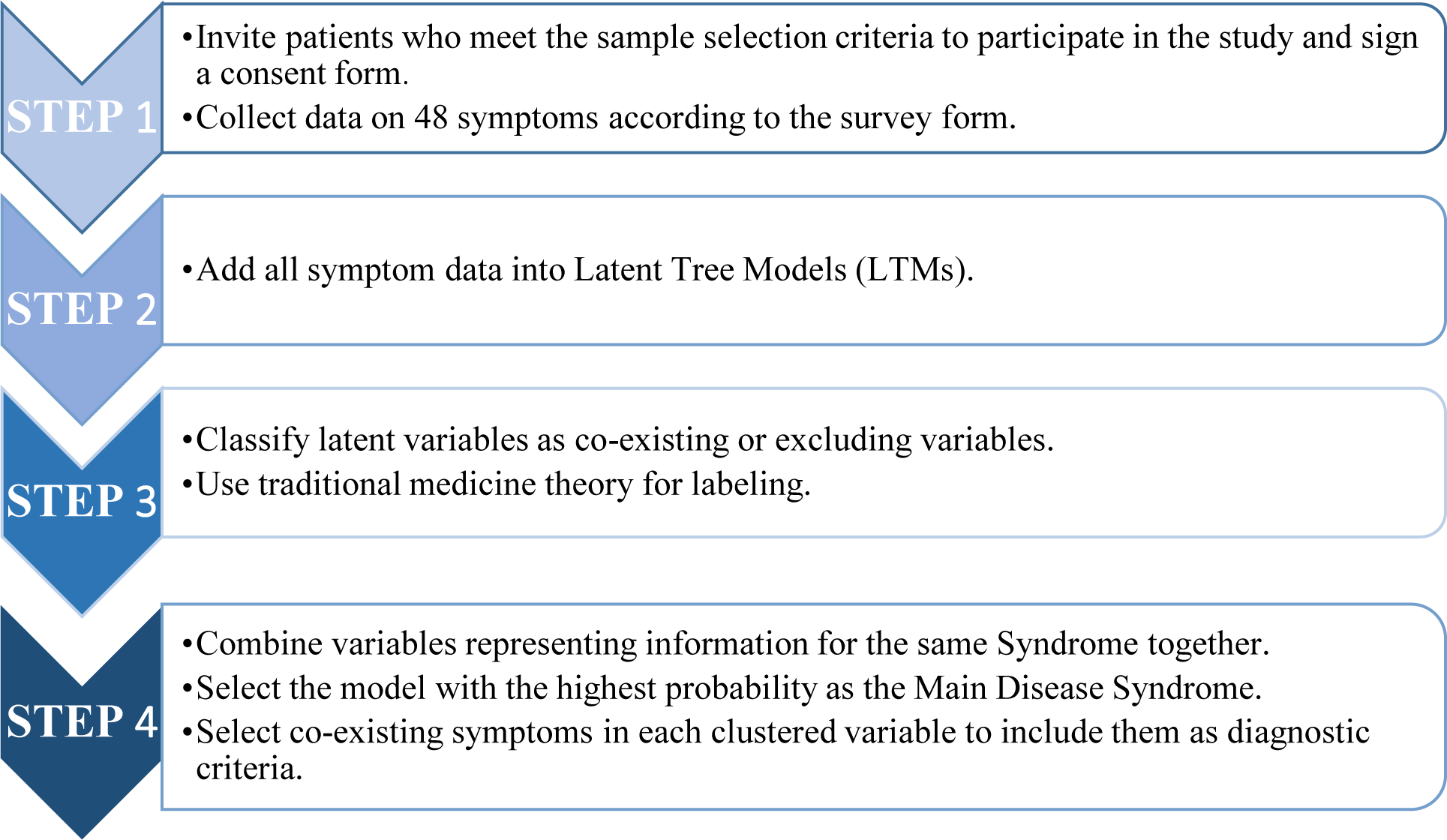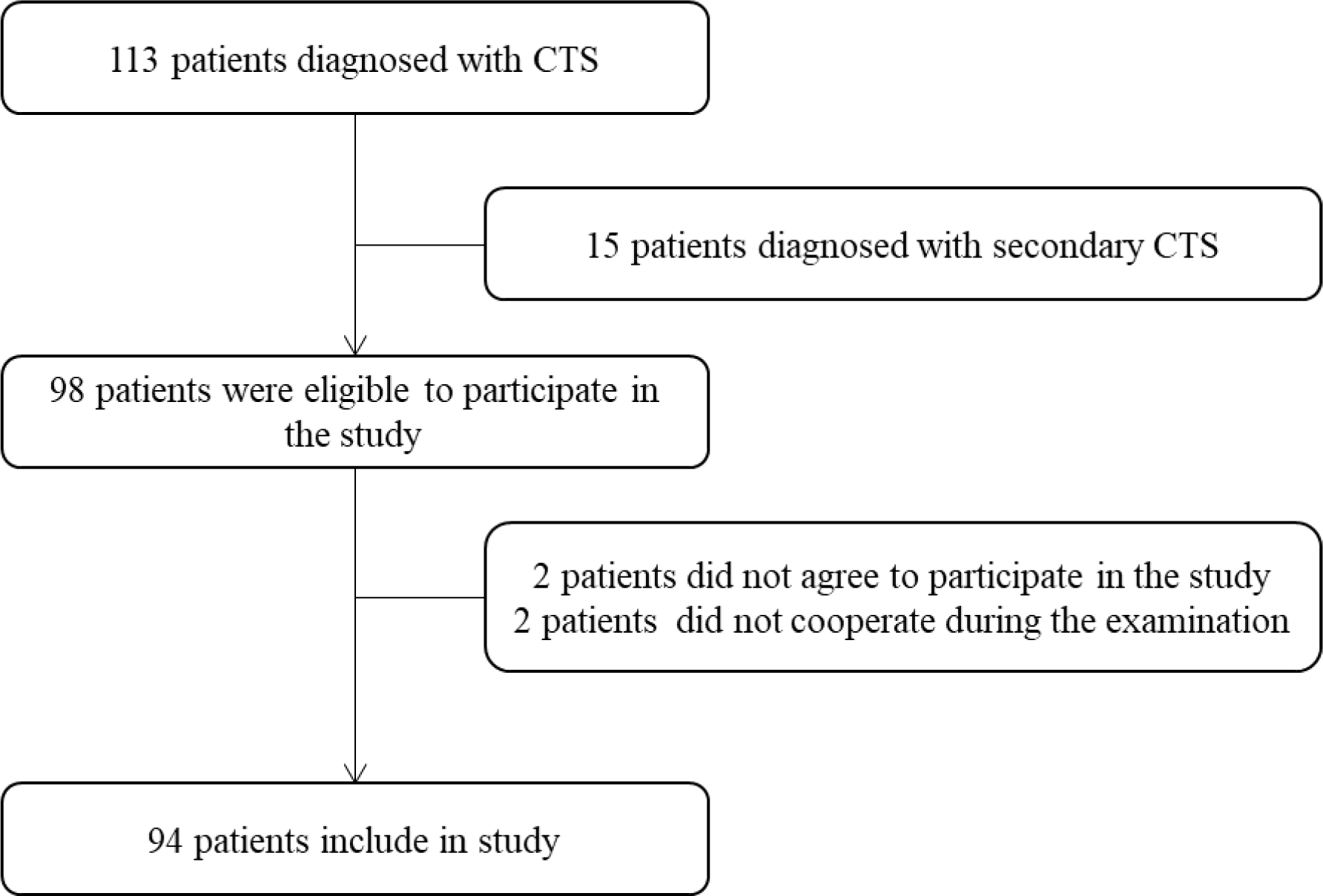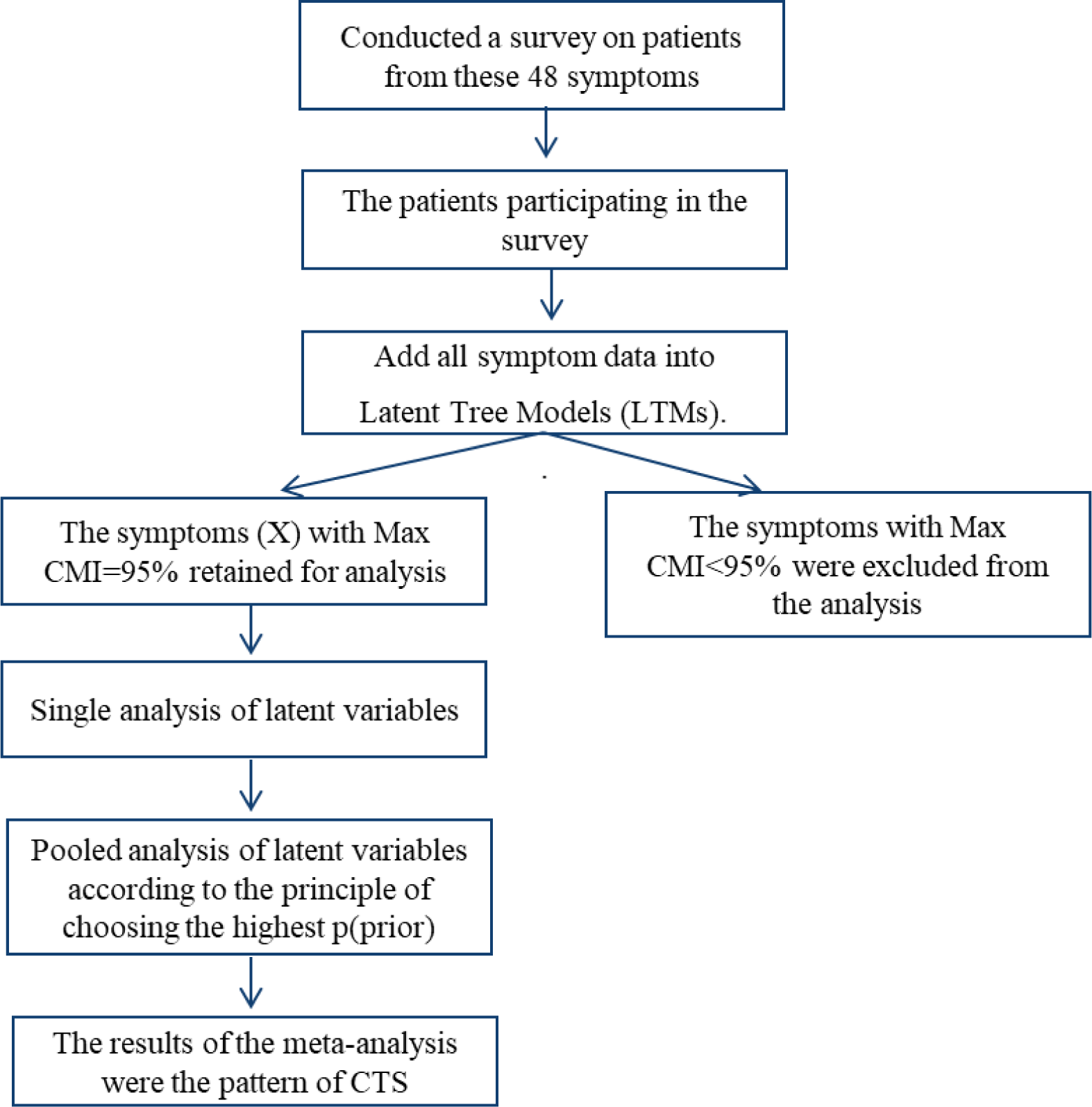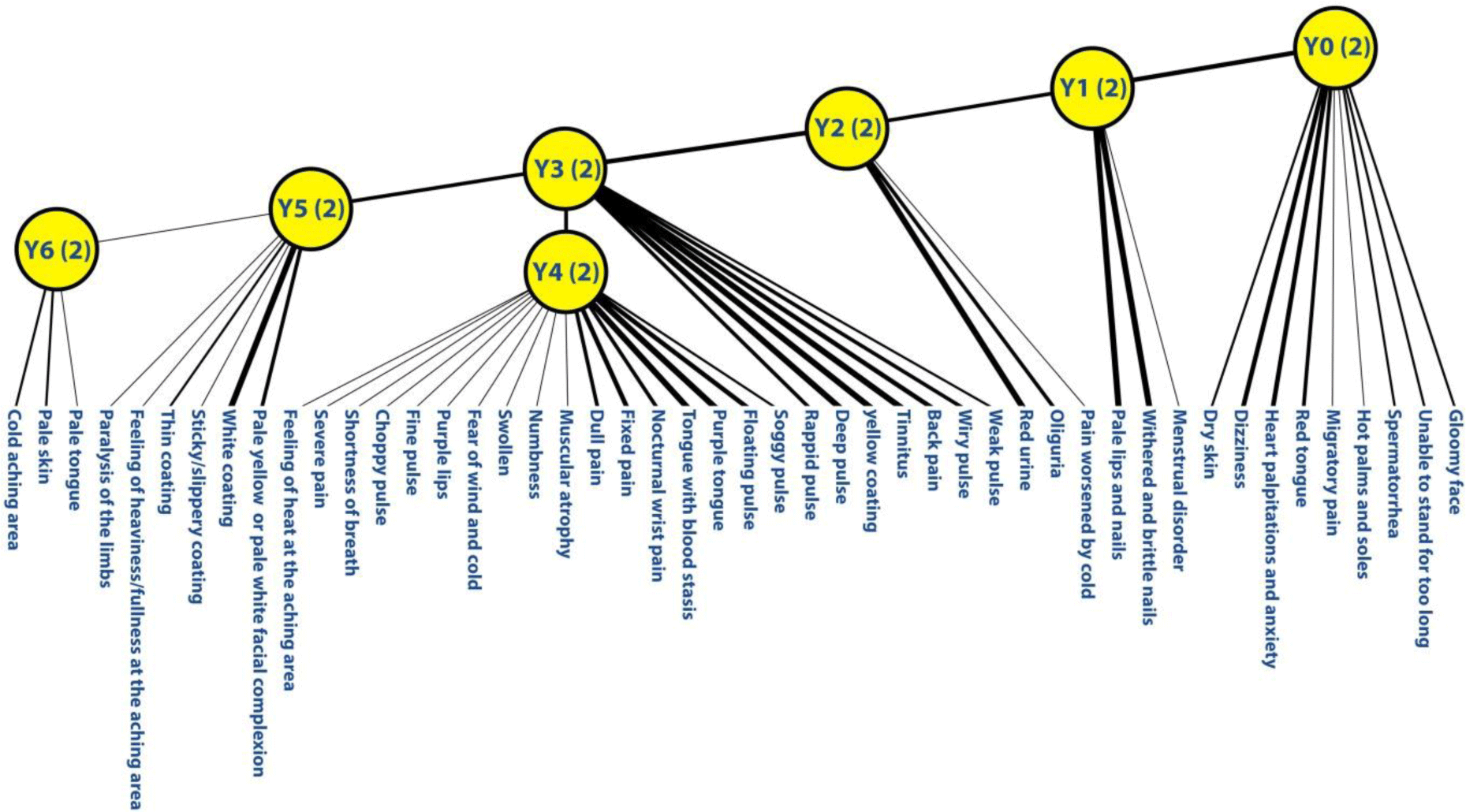1. INTRODUCTION
Carpal tunnel syndrome (CTS) is a nerve compression disease in the carpal tunnel, accounting for 90% of nerve compression diseases with 3.8% of the population suffering from it [1, 2, 3]. The disease is characterized by symptoms of numbness and tingling pain, decreased or loss of sensation in the innervation of the median nerve; even more severely, it will be the limitation of motion or atrophy of the muscle tissue of the thumb [4, 5]. Although not life-threatening, carpal tunnel syndrome seriously affects patients’ quality of life. When CTS is diagnosed and treated early, it will have a good effect and minimize complications [4, 6].
CTS was first described by Paget in the 19th century [1], traditional medicine has no specific concept nor specific diagnostic criteria for CTS. Traditional medicine only names the symptoms present in CTS such as wan tong (wrist pain), shou zhi ma mu (numbness) [5, 7]. In the world, there have been many studies proving the effectiveness of traditional medicine in the treatment of CTS [12, 13, 14]; The problem is that the treatment with traditional medicine methods needs to follow the principle of diagnosing traditional medicine to achieve better results, this has been proven by many studies around the world [8]
Latent Tree Models (LTMs) are a type of model that is potentially useful in finding latent variables from intuitive variables obtained in practicality [9, 10, 11]. This model is used in many countries and becomes increasingly popular in Vietnam.
Therefore, our study aims to identify common symptoms of each patterns of patients diagnosed with CTS according to traditional medicine, thereby building diagnostic criteria for each patterns of traditional medicine.
2. MATERIALS AND METHOD
Our study is a descriptive cross-sectional study on the patients with primary CTS at The 3rd branch of University Medical Center HCMC and Thong Nhat Hospital from March 2021 to June 2021.
-
- Stage 1: Survey the medical literature. Medical literature is defined as all documents that are textbooks used at domestic and foreign universities specializing in traditional medicine. Research results collected 10 medical literature and 48 traditional medicine symptoms described in CTS. From these 48 symptoms, an expert opinion survey was conducted, and the consensus of 10 traditional medicine experts in Vietnam was reached. Therefore, we conducted a survey on patients from these 48 symptoms.
-
- Stage 2: Survey on patients. The steps to carry out the study are shown in Figure 1.
Patients has one of the following criterias:
-
Patients with wrist injury or inflammation
-
Patients with language disorders, cognitive disorders, mental disorders or dementia cannot communicate with doctors or cannot follow medical orders.
-
Patients with acute diseases need to be actively managed with modern medicine.
-
The patients did not cooperate during the examination.
-
The patients did not agree to participate in the study.
where n is the number of sample sizes needed for the study; z1-α/2=1.96, d= 0.05. According to Moutasem SA [1], P =0.5, with 10% expected loss, the total sample of the study was 384.
Collect data through survey form. Process and analyze data using Excel 2016 and Lantern 5.0 software.
Total of 48 symptoms according to medical literature after having been collected from clinical patients encrypted into binary code with two parameters 0 (no) and 1 (yes).
To estimate the degree of correlation between symptom variables and latent variables, this model is based on CMI (Cumulative Mutual Information percent). In these researches, we chose 95% as the maximum CMI percentage (Max CMI = 95%), meaning the presence of symptom variables reaching Max CMI = 95% indicates 95% of the information about latent variables. CMI will represent the degree of correlation between the symptom variables and latent variables. This correlation is visually represented by the width of the linking bar. As for LTM, symptoms appearing 100% or not appearing are of no value in differentiating Pattern and therefore are not included in any Pattern at all.
Processing the data with CMI = 95% gave results of the main symptoms indicating 95% of the information about latent variables, secondary symptoms providing less information were skipped over. As for the main symptoms, we apply Traditional Medicine theory to label them.
The latent variables all indicate a piece of information about a Traditional Medicine syndrome that we analyze using the joint clustering model available in LTMs; co-existing and omitted forms are joint in various ways, producing many models with different emerging parameters p (prior). The most efficient model that we chose is the model with the highest p (prior), each model will consist of symptoms reaching CMI 95%. They are the main symptoms to diagnose the pattern.
This study was approved by the Ethics Board in Biomedical Research at University of Medicine and Pharmacy at Ho Chi Minh City on January 28th 2020, No.122/ÐHYD-HÐÐÐ. All the participants signed an informed consent form in which the personal identification of study objects was not reported (name, address). The research process is strictly in accordance with the Declaration of Helsinki.
3. RESULTS
The characteristics in common of the samples shown in Table 1.
There are a total of 48 symptoms according to medical literature after having been collected from 94 clinical patients encrypted into binary code with two parameters 0 (no) and 1 (yes). After applying the Latent Tree Model, we get a model as shown in Figure 2.
There are 7 latent variables (from Y0 to Y6) drawn from this model. The numbers in parentheses are the number of statuses that latent variables indicate. This study has Numbness syndrome with 100% appearance rate and 4 symptoms: Feeling of heat at the aching area; shortness of breath, dyspnea; soggy pulse; choppy pulse which do not emerge completely are not included in any pattern at all.
Processing the data with CMI = 95% gave results of the main symptoms indicating 95% of the information about latent variables, secondary symptoms providing less information were skipped over. As for the main symptoms, we apply Traditional Medicine theory to label them as in Table 2.
The latent variables all indicate a piece of information about a Traditional Medicine syndrome that we analyze using the Joint clustering model available in LTMs; co-existing and omitted forms are joint in various ways, producing many models with different emerging parameters p (prior). The most efficient model that we chose is the model with the highest p (prior), each model will consist of symptoms reaching CMI 95%. They are the main symptoms to diagnose the Pattern.
After conducting combined analysis, blood stasis (latent variable Y4) has the highest p= 0.49 so it is chosen as a clinical pattern of CTS, the symptoms of Y4 are also picked as diagnosis criteria for blood stasis.
After specific analysis on each latent variable and analysis on clustered variables, we got 5 syndromes of CTS and the following symptoms.
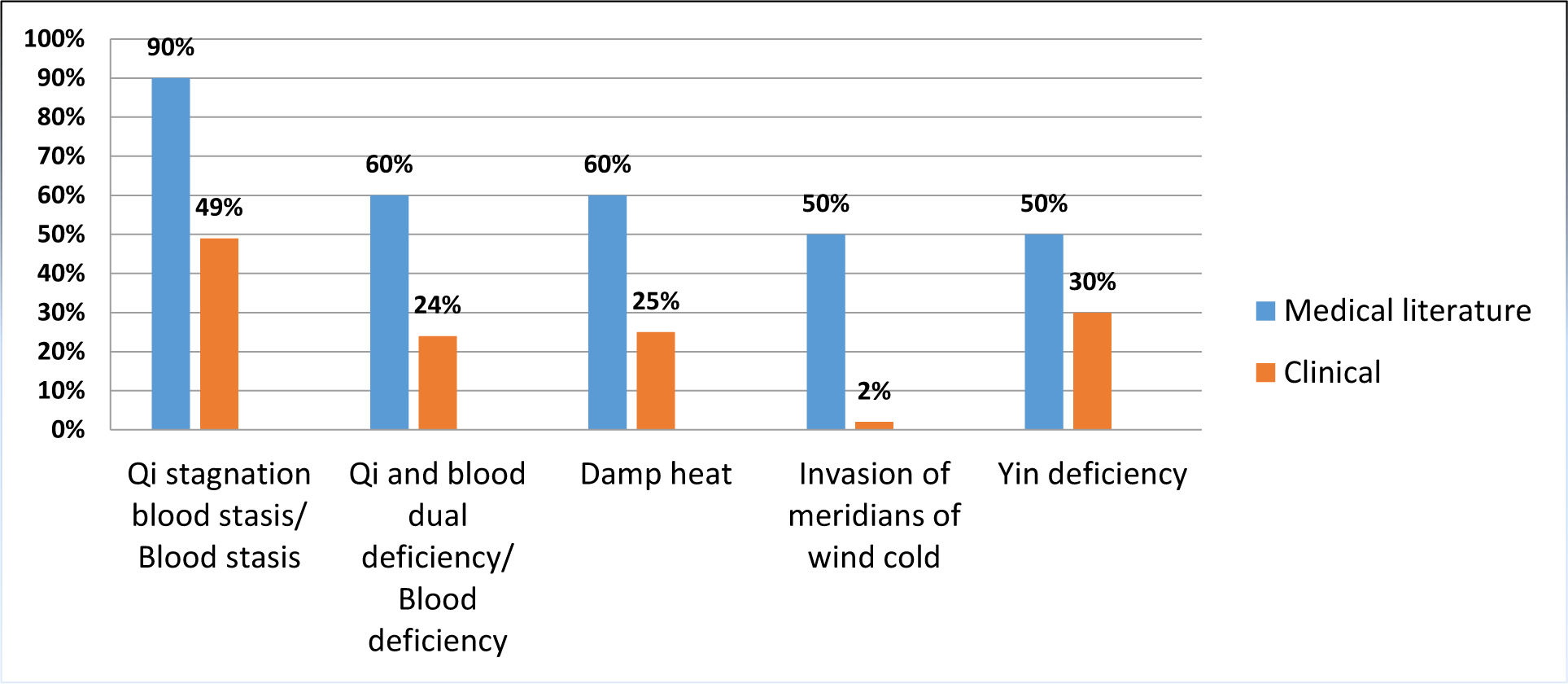
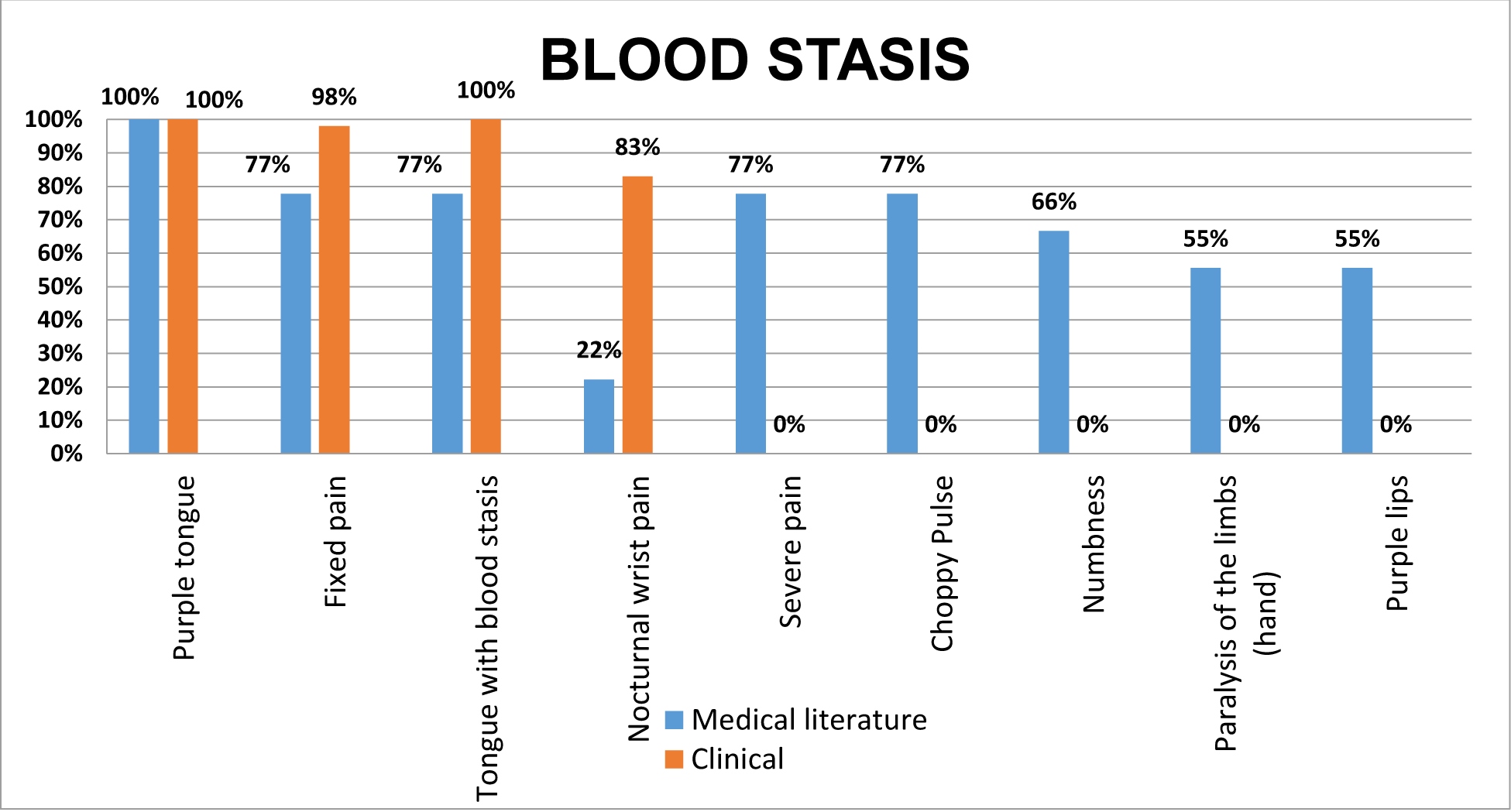
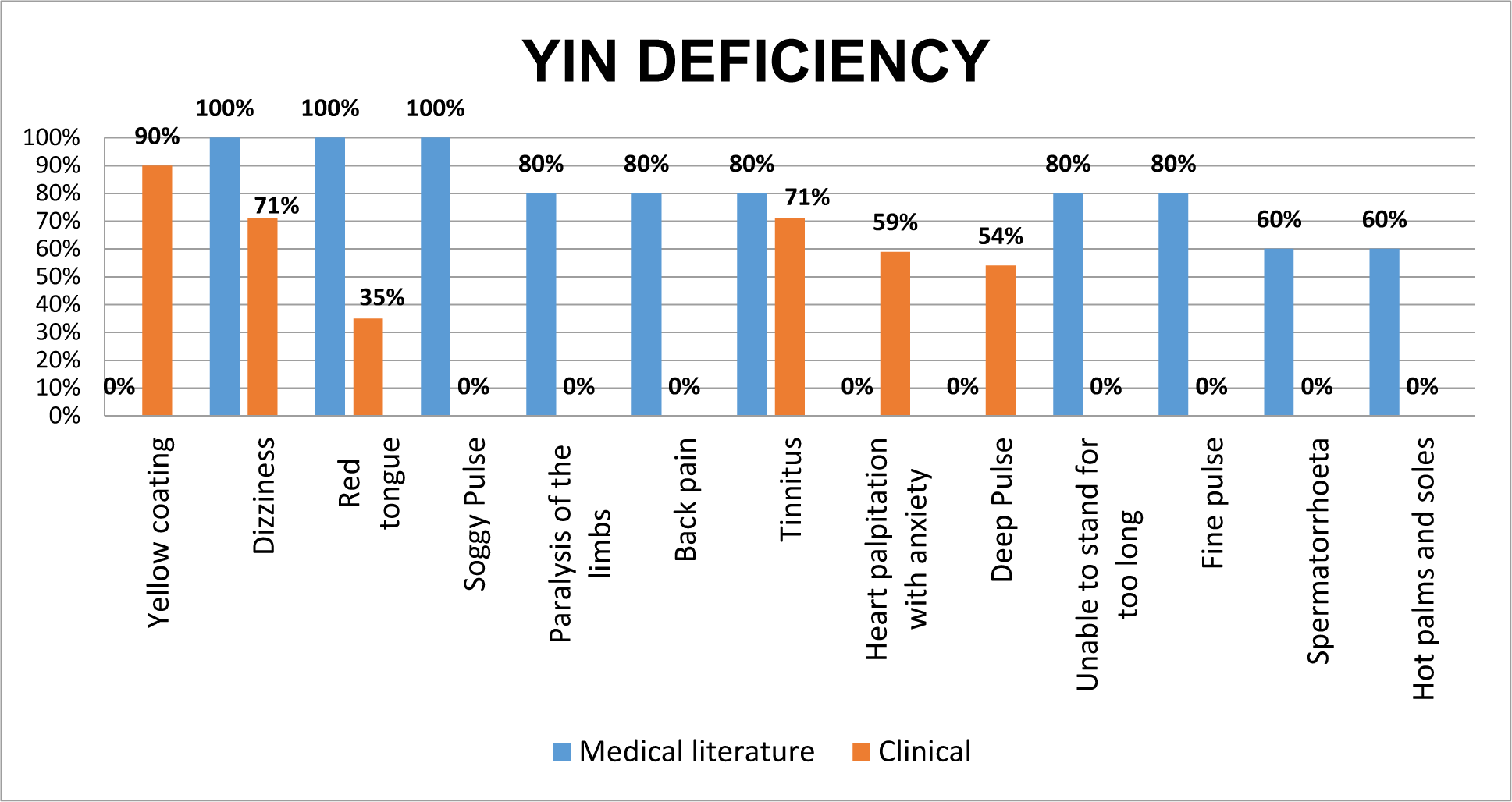
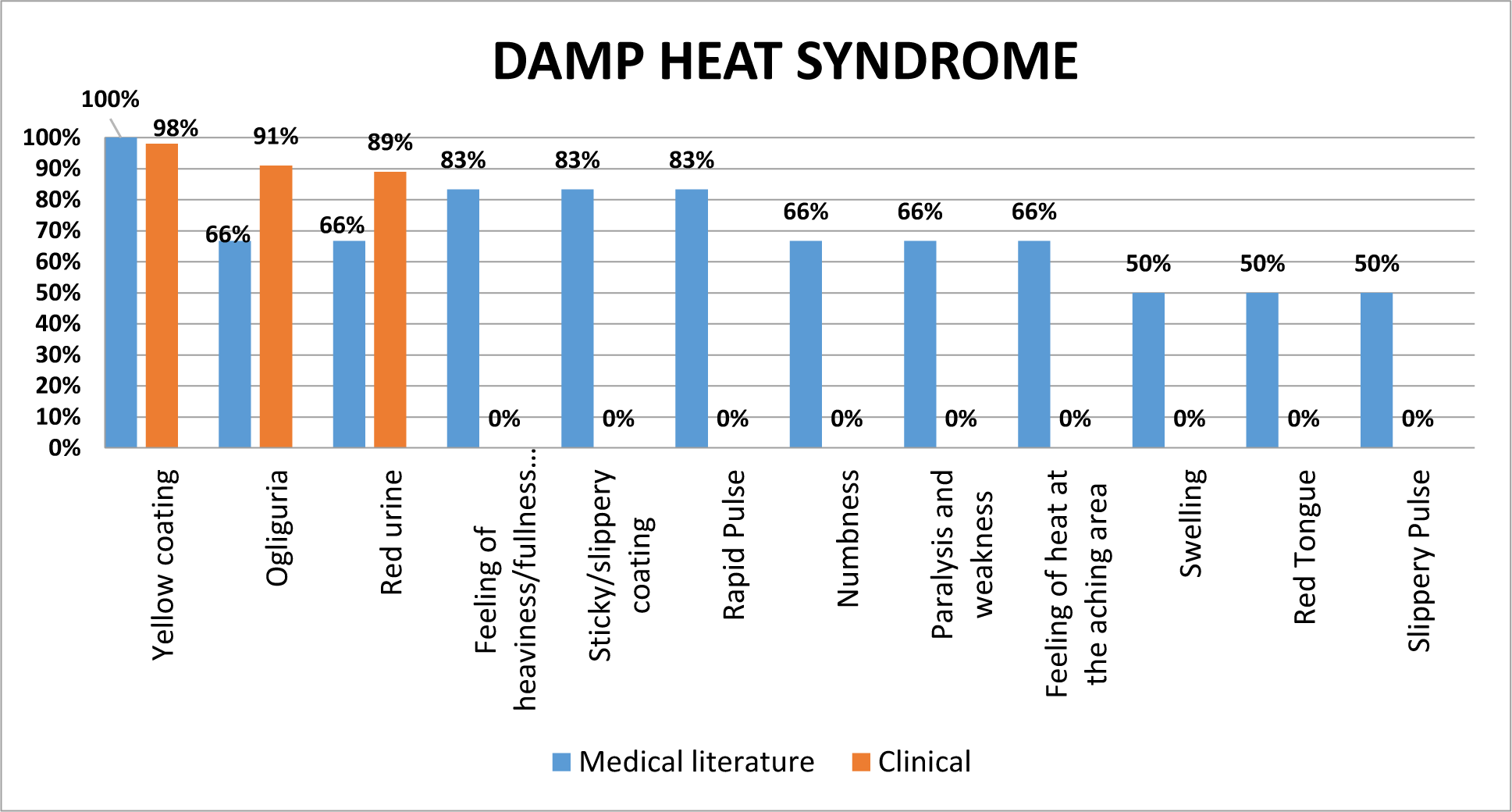

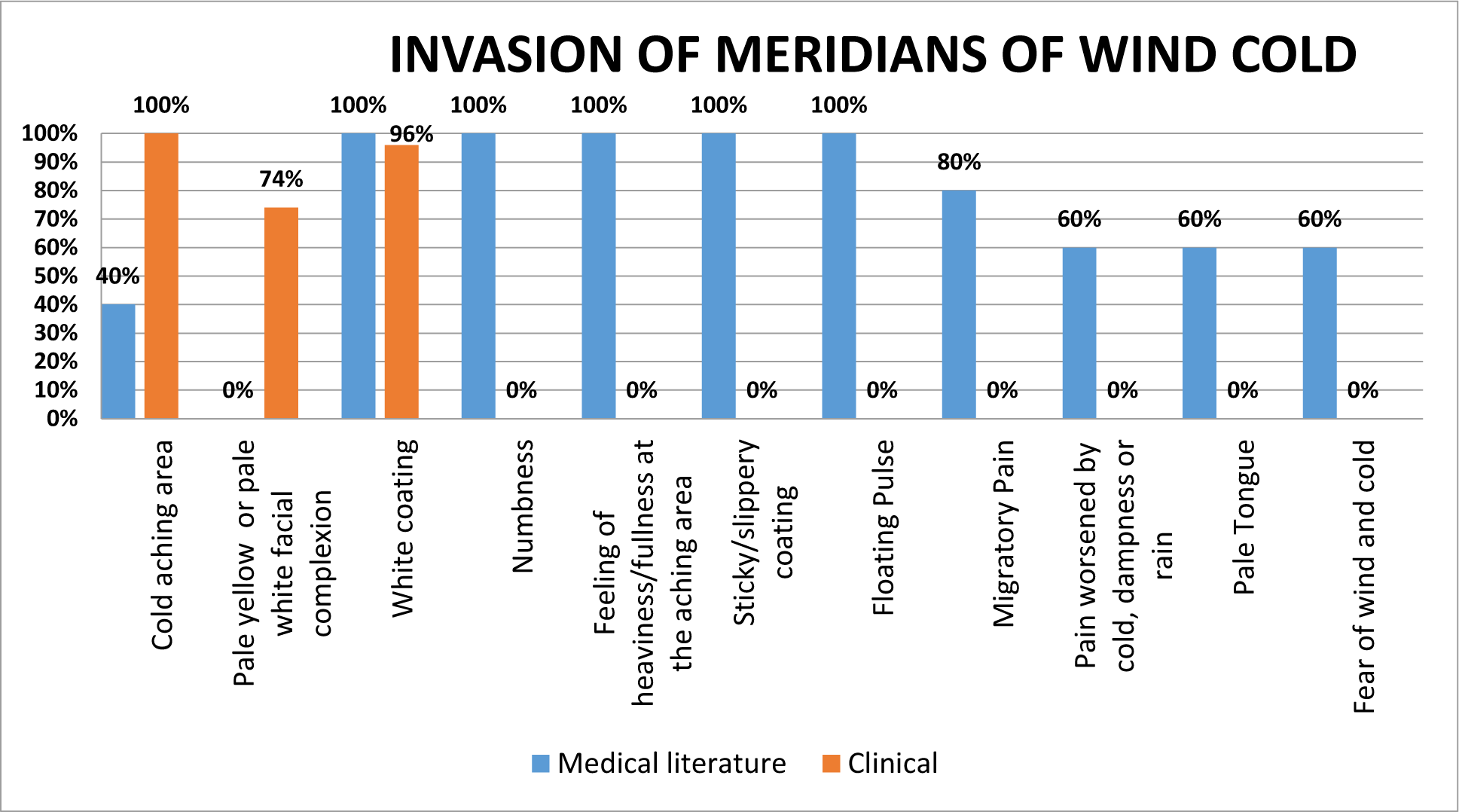
4. DISCUSSION
The majority of patients surveyed in the study are in the age group of 30 - 60; very few patients with CTS are under 30 years of age. This is the working age group. As CTS results from working involving excess use of wrists, this is understandable.
According to the study of Le Thi Lieu, CTS occurs mostly to the middle-aged (40 – 60 years of age), making up 74.5% [15]. The concentrated age groups of researchers around the world are also mostly 40 - 60 years of age [9],[20],[21],[22].
For CTS, females make up the majority of the patients. In this research, the percentage of females is 70.2% and the percentage of male is 29.8%. The result of this study is similar to those of author Huynh Dang Bao Cuong [16], Phan Xuan Nam [17] and foreign author Ahmad Reza Ghasemi-Esfe [18]. Female patients in these study all make up more than 2/3 of the CTS cases, 70%, 79.1% and 77% to be specific [16], [17], [18].
The percentage of female patients is 2.36 times higher than that of male patients. This is understandable as females’ work tends to involve more use of the wrist than male’s work does [19].
In the sample, patients diagnosed with CTS concentrate the most in two occupations: office workers and housewives, both of which make up 14.9%. The next one is farmers which make up 12.8%. In the sample, the amount of wrist use larger than 20 hours/week makes up 82.9%; meanwhile, those who use the wrist little (wrist using time < 15 hours/week) such as soldiers or students account for only 18.1%.
According to Le Thi Lieu’s research, housewives and farmers, which are more common than certain other occupations such as office workers or artisans, make up 20% and 29% respectively [15]. In Huynh Dang Bao Cuong’s research, the percentage of housewives occupation among CTS patients is 30.9% [16].
Researches all indicate that some occupations could be potential risks of CTS, especially jobs that require frequent and prolonged flexion and flip of the wrist. In these positions, pressure in the wrist will intensify, affecting the median nerve. For a prolonged period, the nerve could be damaged, causing CTS [19],[20].
In the study group, 86.2% of the patients has an average BMI (18.5 - 22.9); BMI within the overweight range (23 - 24.9) accounts for 9.6%. Only 2.1% of patients are underweight (BMI < 18.5) and 2.1% are obese (BMI > 25). The majority of patients with CTS have normal BMI or are overweight. In Le Thi Lieu’s research, 54.5% of the patients have average BMI (18.5 – 22.9); BMI 23 (overweight) makes up 39% and only 6.5% has BMI < 18.5 [15]. In conclusion, patients with average BMI of both researches account for the highest percentage. This can be put down to the physical conditions of the Vietnamese, most of whom have average BMI. Though obesity with BMI ≥ 30 is also a potential risk of CTS [15], this sample recorded no case of BMI ≥ 30.
In this research, cases of injury or inflammation at the wrist are excluded in order to ensure recorded cases have CTS as the primary cause [15],[21]. Most patients surveyed have some concomitant illnesses, mostly musculoskeletal - mental health disorders such as sciatica pain, osteoarthritis or degenerative spine; these make up 70.2%; following cases are heart diseases such as hypertension, dyslipidemia [22]. Among 66 patients with concomitant diseases, there are 23 with > 1 disease, making up 34.8%.
Most patients assembled in the study get examined and treated for CTS for the first time; they make up 97.9%. Onset circumstances of the disease are mostly unclear. Patients feel pain from the wrist to the fingertip where gradual numbness is felt; however, situation of carpal tunnel syndrome’s symptoms can be pinpointed clearly: activities involving much use of the wrists such as workers with jobs requiring heavy computer use [19], sewing, cooking, cleaning, driving,… Only a few patients have onsets after holding or carrying objects with too much weight. Onset conditions of the disease also somehow explain the fact that most examined patients complain about pain, dullness, and numbness more than intense pain [20].
In Le Thi Lieu’s research, most patients experience symptoms of CTS when cycling or riding for 10 – 15 minutes. The percentage of onset conditions is 88.4% [16]. In Phan Xuan Nam’s study (2013), the probability of CTS when riding is 76.1% [17].
In conclusion, most CTS onsets take place after activities involving vibrating machines or continuous and prolonged flexion and extension of the wrist.
Collected sample has a quite small number, only 94 patients with CTS are included in the research. Furthermore, only 40/48 symptoms were recorded, there are still 8 symptoms which are not yet recorded clinically.
A symptom that most patients have is “numbness” in the wrists, hands, and fingers (finger 1-4), accounting for 100%. This is also the biggest complaint among patients with CTS. This symptom also accords with median nerve compression in the carpal tunnel caused by repeated movement of the wrist for long periods of time.
Dull pain is present much more than intense pain (62.8% compared with 4.3%), this symptom synergizes with gradual onset conditions with no clear onset element collected from Onset conditions of the sample. Fixed pain makes up the larger percentage than migratory pain (56.4% compared with 30.9%), nocturnal wrist pain also accounts for a quite high percentage in the sample (43.6%). Symptoms with frequent emergencies synergize with characteristic symptoms of CTS.
There are 8 symptoms absent from the sample: Feeling of heat at the aching area, shortness of breath, dyspnea, choppy pulse, fine pulse, fear of wind and cold, oedema, muscular atrophy, menstrual irregularity; “Paralysis of the limbs” symptom is present in only 1/94 patients. Due to the small size of the collected sample, patients are examined for minor - moderate symptoms at The 3rd branch of University Medical Center HCMC, Thong Nhat Hospital; no clear severe case with Amyotrophic or Paralysis and weakness is yet to be recorded.
This is the syndrome with the most frequent emergence both in medical literature and clinically (90% compared with 49%). According to medical literature, qi stagnation & blood stasis consists of 14 examined symptoms, among which 8 symptoms have an appearance rate > 50%, 6 symptoms are excluded. Clinically, blood stasis is examined with single-group analysis for 48 symptoms in medical literature; 4/14 symptoms described in medical literature are present, the rest are excluded.
Clinical symptoms with co-existing Max CMI 95% and high percentages of co-existence are very characteristic of blood stasis. However, the number of symptoms complementing qi stagnation is quite small so only blood stasis syndrome is mentioned. Numbness is present among all examined patients, making up 100%; this is of no diagnostic value and thus is not included. Choppy pulse is not present in the sample while paralysis & weakness only accounts for a modest 1/94 and purple tongue 8/94; both do not coexist with the 4 symptoms above. Nocturnal wrist pain symptom only makes up 22.22% according to medical literature while clinical practice introduces a quite high rate of the symptom.
According to clinical practice, purple tongue and tongue with blood stasis are also categorized into blood stasis syndrome. Because this specificity, along with the co-existence, make up the highest percentage in the sample, they are of great diagnostic value for blood stasis in patients with CTS.
This is a syndrome that appears quite a lot in both the medical literature and clinical practice (50% and 30%). Based on the medical literature, the disease name of kidney damage has 13 symptoms in total examined, of which 10 symptoms appear with a frequency of over 50%, and 3 symptoms are excluded. Clinically, yin deficiency syndrome was investigated by single and group analysis with 48 symptoms according to the literature, while there were 3 out of 13 symptoms appearing similar to the medical literature, the remaining 10 symptoms were excluded, and there were 3 more symptoms: Deep pulse, heart palpitation with anxiety, and tongue with yellow coating.
Clinical symptoms with Max CMI 95% co-exist with a very high rate in latent variable Y0 (named as yin deficiency), variable Y2 (named as damp heat 1) and Y3 (named as damp heat 2) with p(s1) of 22%, 25% and 21% respectively. After pooling and analyzing the above variables, the pooled variable Z1 accounted for 30%, including the 6 symptoms mentioned above. Thready pulse symptom does not appear in the sample, the symptom of paralysis and weakness is only 1 out of 94, the symptom of Spermatorrhoea accounts for 1/27 (male), the symptom of unable to to stand, sit for a long time accounts for 3/94, and the symptom of hot palms and soles is 13/94, which is quite small and does not co-occur in the single group, as well as, combine with the above 6 symptoms, so it is excluded from the standard. Symptoms of red tongue based on the medical literature account for 100%, but in clinical practice, the percentage of that is lower.
This is a syndrome that appears quite a lot in both the literature and clinical practice (60% and 25%). Based on the medical literature, the name damp heat has 15 symptoms in total investigated, of which 13 symptoms appeared with a frequency of over 50%, and 2 symptoms were excluded. Clinically, damp heat syndrome was investigated by single-group and grouped analysis with 48 symptoms based on the medical literature, with 3 out of 15 symptoms appearing similar to the literature, and the remaining 12 symptoms were excluded.
Clinical symptoms with Max CMI 95% co-present with a very high rate in latent variables Y2 (named damp heat 1) and Y3 (named damp heat 2) with p(s1) of 25% and 21%, respectively. After conducting pooling and analyzing the above variables, the pooled variable Z2 accounted for 25%, including the 3 symptoms mentioned above. Symptoms of numbness appeared in all surveyed patients, accounting for 100%, so there was no diagnostic value for this syndrome, and it was not included. Symptoms of tongue with yellow coating accounted for the highest percentage of all symptoms investigated both in the literature and in clinical practice. Among the above symptoms, there are symptoms of oedema and symptoms of Feeling of heat at the aching area do not appear in the sample, and the symptom paralysis & weakness only accounts for 1 out of 94, quite small, and does not co-occur in the single-group as well as in the combination of the 3 symptoms above; so it should be excluded from the standard. Symptoms heaviness at the sores occurs clinically at a very high rate, but it does not co-exist with the above symptoms and is also excluded.
The syndrome appears quite a lot in both the medical and clinical literature (60% and 24%). Based on the medical literature, qi & blood dual deficiency has 21 investigated symptoms in total, of which 11 symptoms appear with frequency of over 50%, and 10 symptoms are excluded. Clinically, blood deficiency syndrome was investigated by single and group analysis with 48 symptoms based on the literature, 3 out of 21 symptoms appeared similar to the literature, the remaining 18 symptoms were excluded, and there was 1 more symptom: Withered and brittle nails.
Clinical symptoms with Max CMI 95% co-exist with a very high rate in latent variables Y0 (named blood deficiency 1), Y1 (named blood deficiency 2) and Y5 (named blood deficiency 3) with p(s1) of 22%, 23% and 41%, respectively. After pooling and analyzing the above variables, the pooled variable Z3 accounted for 24% including the 4 symptoms mentioned above. Symptoms of numbness appeared in all surveyed patients, accounting for 100%, so there was no diagnostic value for this syndrome, and it was not included. The two symptoms of dizziness and heart palpitation with anxiety accounted for the same highest rate of all symptoms investigated both in the literature and in clinical practice. Among the above symptoms, there is a symptom of fine pulse that does not appear in the sample, the symptom of paralysis & weakness accounts for only 1/94, which is quite small and does not occur in a single group as well as in the combination of variables with the above 4 symptoms, so it is excluded from the criteria. The remaining symptoms appeared clinically at a very high rate but did not coexist with the above 4 symptoms, and they were also excluded.
The syndrome appears quite a lot in both the literature but has very low clinical practice (50% and 2%). It may be because the area of Ho Chi Minh City is tropical, the wind cold is rare or because the sample scale is small, we also have a small percentage. Based on the medical literature, the disease has 12 symptoms in total investigated, of which 09 symptoms appear with frequency of over 50%, and 03 symptoms are excluded. Clinically, Invasion of meridians of wind cold pattern was investigated by single and group analysis with 48 symptoms based on the literature, 2/12 symptoms appeared similar to the literature, the remaining 10 symptoms were excluded, and 1 more symptom was pale yellow or pale white facial complexion.
Clinical symptoms with Max CMI 95% co-exist with a very high rate of 41% and 2% in latent variables Y5 (named wind cold 1) and Y6 (named wind cold 2) with p(s1) respectively. After conducting pooling and analyzing the above variables, the pooled variable Z4 accounted for 2%, including the 3 symptoms mentioned above. Symptoms of numbness appeared in all surveyed patients, accounting for 100%, so there was no diagnostic value for this syndrome, and it was not included. Among the above symptoms, the symptoms of fear of wind and cold did not appear in the sample. The remaining symptoms appeared clinically at very high rates, but they did not co-occur in the single group nor were they combined with the above 4 symptoms, and they were also excluded.
Our study only conducted a survey on a group of patients with primary CTS, in a short period of time and during the Covid-19 epidemic, so the sample size obtained was relatively small. We have done multicenter (in 2 large hospitals in Ho Chi Minh City but have not been able to get a larger sample size). In the future, we will continue to survey on more patients.
However, all the data collection and processing is done seriously and scientifically, so the results of our study have real clinical and academic significance.
Conclusion
The results of our study show 5 commonly patterns of patients with primary carpal tunnel syndrome, these 5 patterns are consistent with many previously recorded medical literatures. These 5 main patterns: Blood stasis has 4 symptoms to diagnose, yin deficiency has 6 symptoms to diagnose, damp heat has 3 symptoms to diagnose, blood deficiency has 3 symptoms to diagnose and invasion of meridians of wind cold has 3 symptoms to diagnose.
The results of our study have built a list of diagnostic criteria for common traditional medicine clinical patterns of CTS. A large, representative population study should be performed to confirm the results of this study.









